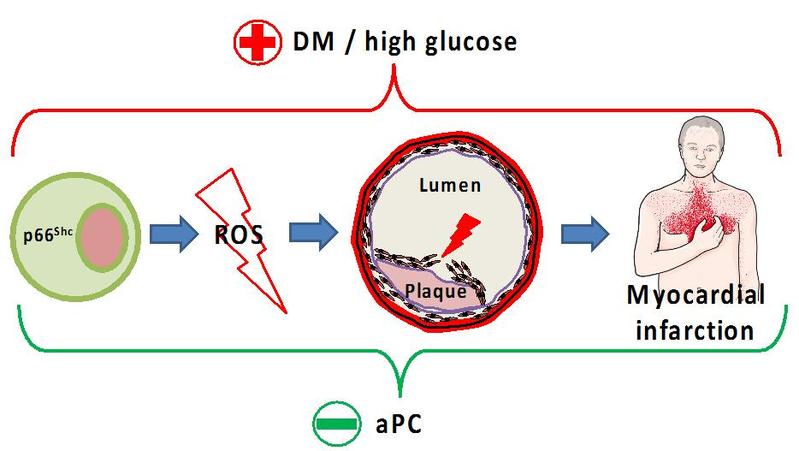

Diabetes mellitus (DM) and the associated hyperglycaemia cause an increase of the redox-protein p66Shc and reactive oxygen species (ROS) in macrophages, causing instable plaques, which predisposes diabetic patients to myocardial infarction. These effects are counteracted by the cytoprotective effects of the coagulation protease activated protein C (aPC). Human torso reflecting myocardial infarction symptoms is taken from https://smart.servier.com
The major cause of mortality and morbidity among diabetic patients is atherosclerosis and its associated complications like myocardial infarction, stroke, and peripheral vascular disease. While the more aggressive disease progression of atherosclerosis in diabetic patients is established, the underlying mechanisms remain obscure, hampering specific therapeutic approaches to atherosclerosis in diabetic patients.
A hallmark of diabetes-associated atherosclerosis is the perpetuated disease progression despite marked improvement of blood glucose. The sustained disease progression despite improved blood glucose is known as the hyperglycaemic memory – a phenomenon that is equally disappointing and discouraging for patients and doctors.
Scientists led by Prof. Dr. Berend Isermann and Dr. Khurrum Shahzad of the Institute for Clinical Chemistry and Pathobiochemistry at the OVGU and the Magdeburg Health Campus Immunology, Infectiology and Inflammation (GC-I³), unravelled now a new mechanism underlying the hyperglycaemic memory.
They established that in macrophages, inflammatory cells accumulating in the atherosclerotic plaques, more reactive oxygen species are generated as a consequence of increased expression of a redox regulator protein known as p66Shc. Importantly, this protein is specifically expressed in diabetic atherosclerotic lesions, but not in patients or mice without diabetes.
Furthermore, despite normalization of blood glucose levels, expression of p66Shc and hence generation of reactive oxygen species remained high. This identifies the p66Shc-dependent ROS generation as a new mechanism contributing to an impaired plaque stability in diabetic patients. ROS alters the protein and thus the cell function.
But the scientists did not only identify this new mechanism as a characteristic feature of diabetic atherosclerosis. In addition, they were able to correct p66Shc-dependent ROS generation using several supplementary approaches using in vivo models. Thus, they were able to show that the coagulation protease activated protein C reverses the diabetes-specific changes. This establishes that the newly identified mechanism is therapeutically amendable.
“It is now the challenge to confirm these results in larger clinical studies” says Prof. Isermann. Dr. Shahzad adds “In parallel we will devise ways to tackle this pathway therapeutically”. The researchers hope that these insights will lay ground to an individualized therapeutic concept for diabetic patients with atherosclerosis.
Figure:
Diabetes mellitus (DM) and the associated hyperglycaemia cause an increase of the redox-protein p66Shc and reactive oxygen species (ROS) in macrophages, causing instable plaques, which predisposes diabetic patients to myocardial infarction. These effects are counteracted by the cytoprotective effects of the coagulation protease activated protein C (aPC). Human torso reflecting myocardial infarction symptoms is taken from https://smart.servier.com.
doi:10.1038/s42003-018-0108-5;
https://www.nature.com/articles/s42003-018-0108-5












